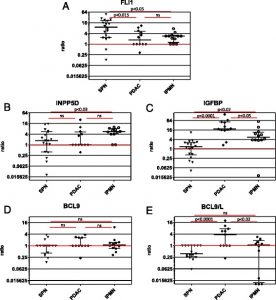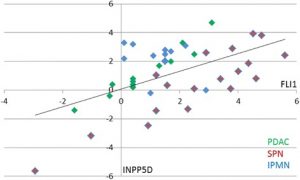BACKGROUND: Solid pseudopapillary neoplasms of the pancreas (SPN) are rare tumors affecting mainly women. They show an activating mutation in CTNNB1, the gene for β-catenin, and consequently an overactivation of the Wnt/β-catenin pathway. This signaling pathway is implied in the pathogenesis of various aggressive tumors, including pancreatic adenocarcinomas (PDAC). Despite this, SPN are characterized by an unusually benign clinical course. Attempts to explain this lack of malignancy have led to the discovery of an aberrant expression of the transcription factor FLI1 in SPN.
 METHODS: In 42 primary pancreatic tumors the RNA-expression of the FLI1 targets DKK1, INPP5D, IGFBP3 and additionally two members of the Wnt/β-catenin pathway, namely BCL9 and BCL9L, was investigated using quantitative real time PCR. Expression of these genes was evaluated in SPN (n = 18), PDAC (n = 12) and the less aggressive intraductal papillary mucinous neoplasm IPMN (n = 12) and compared to normal pancreatic tissue. Potential differences between the tumor entities were evaluated using students t-test.
METHODS: In 42 primary pancreatic tumors the RNA-expression of the FLI1 targets DKK1, INPP5D, IGFBP3 and additionally two members of the Wnt/β-catenin pathway, namely BCL9 and BCL9L, was investigated using quantitative real time PCR. Expression of these genes was evaluated in SPN (n = 18), PDAC (n = 12) and the less aggressive intraductal papillary mucinous neoplasm IPMN (n = 12) and compared to normal pancreatic tissue. Potential differences between the tumor entities were evaluated using students t-test.
RESULTS: The results demonstrated a differential RNA-expression of BCL9L with a lack of expression in SPN (p < 0.001), RNA levels similar to normal tissue in IPMN and increased expression in PDAC (p < 0.04). Further, overexpression of the cyclin D1 inhibitor INPP5D in IPMN (p < 0.0001) was found. PDAC, on the other hand, showed the highest expression of IGFBP3 (p < 0.00001) with the gene still being significantly overexpressed in IPMN (p < 0.001). Nevertheless the difference in expression was significant between PDAC and IPMN (p < 0.05) and IGFBP3 RNA levels were significantly higher in PDAC and IPMN than in SPN (p < 0.0001 and p < 0.02, resp.).
 CONCLUSIONS: This study demonstrates a significantly decreased expression of the β-catenin stabilizing gene BCL9L in SPN as a first clue to the possible reasons for the astonishingly benign behavior of this entity. In contrast, high expression of the gene was detected in PDAC supporting the connection between BCL9L expression and tumor malignancy in pancreas neoplasias. IPMN, accordingly, showed intermediate expression of BCL9L, but instead demonstrated a high expression of the cyclin D1 inhibitor INPP5D, possibly contributing to the better prognosis of this neoplasia compared to PDAC.
CONCLUSIONS: This study demonstrates a significantly decreased expression of the β-catenin stabilizing gene BCL9L in SPN as a first clue to the possible reasons for the astonishingly benign behavior of this entity. In contrast, high expression of the gene was detected in PDAC supporting the connection between BCL9L expression and tumor malignancy in pancreas neoplasias. IPMN, accordingly, showed intermediate expression of BCL9L, but instead demonstrated a high expression of the cyclin D1 inhibitor INPP5D, possibly contributing to the better prognosis of this neoplasia compared to PDAC.
Hallas C, Phillipp J, Domanowsky L, Kah B, Tiemann K.
PMID: 27539223; PMCID: PMC4991076; DOI: 10.1186/s12885-016-2707-1